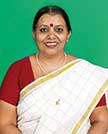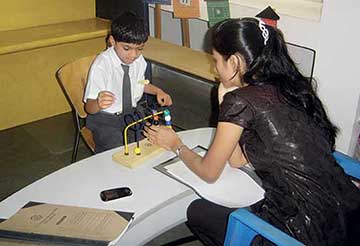 Kalpana has been a special educator and counsellor since 2005. She teaches English to children in the special education centre in her school. Her aim is to help children with special needs to function independently and with confidence and works towards this goal with passion. She keeps herself up breast about research and new techniques and technologies that are developed for children with special needs. She also keeps in constant touch with professionals in her field to both give and take help in this regard whenever necessary.
Kalpana has been a special educator and counsellor since 2005. She teaches English to children in the special education centre in her school. Her aim is to help children with special needs to function independently and with confidence and works towards this goal with passion. She keeps herself up breast about research and new techniques and technologies that are developed for children with special needs. She also keeps in constant touch with professionals in her field to both give and take help in this regard whenever necessary.
Kokilaben Dhirubhai Ambani Vidyamandir (KDAV) in Jamnagar is situated 30 km away from the main city in a clean and green environment. When I first entered its courtyard in 2011 as a special educator, it was amazing to see the help that ‘special ’children were receiving from a set of dedicated parent volunteers. These parents were guided and motivated by Mrs Valli Srinivasan who initiated the special learning centre in the school.
With little training in special education, limited teaching/learning material, and manpower, this dedicated team of 12 faculty members was able to bring noticeable improvement in the children. I was impressed with the progress of this team and asked Mrs. Valli Srinivasan about its beginnings. This is what she had to say.
“I realized that there were always 8 to 10 students in each primary class who were unable to cope with their peers. These children were given remedial help after school hours for about 40 minutes in the subject that they needed help. This was usually done a month before the term exam. Special subject teachers were appointed for this purpose. It was about this time that I started reading books on special teaching techniques and became interested in this area. I moved away from mainstream teaching and started working with two boys from class IV who could not recognize English letters at all. I read from various sources and deployed the techniques I had learnt. In this way I succeeded in helping these boys. Requests soon poured in from teachers asking me to help children in their classes.
 Seeing that there was a need, I decided to attend a one- week training programme conducted by the Madras Dyslexic Assoiciaton (MDA). This programme taught me new teaching techniques, which I began to use with the students in KDAV. We soon employed a psychologist, a special educator, and a visiting psychologist. Parents who were interested also joined us in our mission to make the life of the differently abled kids as ‘normal’ as possible. Our enthusiasm rubbed off on the children, who came to school regularly. Their social as well as academic life improved.”
Seeing that there was a need, I decided to attend a one- week training programme conducted by the Madras Dyslexic Assoiciaton (MDA). This programme taught me new teaching techniques, which I began to use with the students in KDAV. We soon employed a psychologist, a special educator, and a visiting psychologist. Parents who were interested also joined us in our mission to make the life of the differently abled kids as ‘normal’ as possible. Our enthusiasm rubbed off on the children, who came to school regularly. Their social as well as academic life improved.”
This success motivated Mrs. Valli to extend the services of the department to the entire primary school. Since 2011 September, I have been working towards including children from the Special Learning Centre (SLC) into regular classrooms.
The strength in the Special Learning Centre has been slowly and steadily increasing, from around 20 students initially to 50 students today.
The Special Learning Centre presently operates from three rooms. One room each has been given for the learning of mathematics, English, and for conducting gross motor and fine- motor activities. Children visit the centre for five to six periods a week for special learning. In the past two years, my colleagues and I have been able to bring about the following changes in the department:
- Extensively counsel parents and sensitize them to the need of the SLC for their child.
- Arrange for an occupational therapist to visit the centre once a week every month. The therapists help group the children as per the activities needed to improve or enhance their learning.
- Provide extensive awareness programmes for parents and teachers of the pre-primary and primary classes to identify and bring about early intervention.
- Organize regular parent-teacher meetings. During the meeting, parents are told of the improvements in their children, a home-based program is given and follow up session held subsequently.
- Assess the children after every topic is taught.
- Set evaluation papers based on the child’s strengths and weaknesses. Assessment is not always paper-pencil, but a combination of written, oral, and visual and auditory work.
- Use teaching aids like computers, magnetic chalk boards, alphabet tiles, and numbers for teaching.
- Use story books with large font size for reading. Activity based methods are used to understand the concepts of mathematics and language.
In the past two years two children from class 10 and one from class 12 have attempted board exams with disability certificate and passed out with good grades. The journey towards inclusion has just begun. It is our endeavour to see these children enjoy full inclusion in mainstream classroom.
